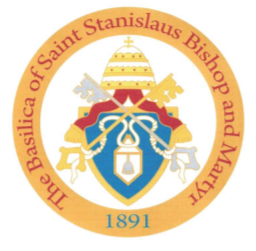- Founding of the Parish
- First Church
- Franciscan Friars Assume Leadership
- Second Church
- Stained Glass Windows and Stations
- Lower Church
- Saint Stanislaus School
- Saint Stanislaus Cemetery
- Church Designated a Basilica
St. Stanislaus Bishop and Martyr Parish was founded and financed by farsighted, hard-worked, and devout Polish immigrants who had arrived in Chicopee in the 1880’s. The young Poles were determined to establish and finance their own church in which they could worship in their own native language, espouse their Polish customs and traditions which they valued highly, and enjoy a sense of acceptance and security. Devotion to God, family, country, the work ethic, and church was the hallmark of the Poles. The parish Polish roots are deep while the branches, which have been growing for more than a century have become widespread. Even a cursory perusal of the parish roster confirms the wide diversity of the ethnic backgrounds of the parishioners.
In 1890 the Bishop entrusted the organization of a Polish church to Rev. Franciszek Chalupka. The first St. Stanislaus Bishop and Martyr Church, a wood-frame church, was located on the parcel of land on which St. Stanislaus School now stands. The first Mass, a midnight Mass, was celebrated by Rev. Chalupka on Christmas 1891 in an unfinished church. It was not only the first church for St. Stanislaus Parish but also the first Polish church in Western Massachusetts.
For a little more than a decade the parish had been under the aegis of a diocesan priest, but early in the twentieth century the spiritual leadership of the parish was entrusted to the Franciscan Friars, Order of Friars Minor Conventual. The Franciscans will observe the centennial of their ministry at St. Stanislaus in July 2002. The parish is a large, vibrant, and cohesive one, but it is no longer an exclusively Polish one. All the pastors have been natives of Poland or Americans of Polish descents. However, many non-Polish priests have ministered in the parish.
The second St. Stanislaus Bishop and Martyr Church, located on Front Street in Chicopee, Massachusetts, was built in 1908 to accommodate the growing number of parishioners. The impressive brownstone, cathedral-like church built in the Baroque Revival Style of architecture has been regarded as one the most imposing churches in the area. The spacious interior of the church can accommodate at least 800 worshipers in the main and two side naves. A pipe organ was installed in the choir loft in 1920.
Some of the most exquisite stained-glass windows, the work of talented European artists, grace the basilica. Each stained-glass window, and there are many, has its own theme. On the walls amid the stained-glass windows on the first level are the Stations of the Cross. The artistically sculpted and painted figures of each Station of the Cross are set in the appropriate niche. The basilica is replete with religious symbolism.
The parishioners have been fortunate to have both an upper and a lower church in which the faithful can worship. The lower church is more contemporary in its architectural style. The lower church is used daily for Masses, for confessions, for the Exposition and Adoration of the Blessed Sacrament as well as for other services. A sizable collection of relics in reliquaries is displayed in special-built cabinets near the sacristy.
Within a decade of the formal establishment of the parish, the parishioners and their pastor deemed it of paramount importance to establish a school which the children of the parish could attend. In the school they would learn the basic skills needed for daily living and receive sound religious instruction. They would also be exposed to the Polish language, culture, and heritage. The children would be taught in Polish and English. Three Felician Sisters opened the first parish school in 1897 using two classrooms in the basement of the church. The Franciscan Sisters of St. Joseph have staffed the school since 1902. Since the middle of the twentieth century, lay teachers have been added to the staff as there has been a dearth of Sisters.
As the school grew, many changes were made. New school buildings were constructed. After the construction of the second church, the first church was converted into a school and parish hall. Within a few years more school space was needed. Section I of the brick school was constructed and opened in 1916. In 1925 the first church was demolished to provide space for Section II of the brick school. The enlarged brick school was opened in 1926. It had served as the parish school and center until 1973 when a devastating fire destroyed it. A new school which had arisen from the ashes was opened on January 5, 1976. The curriculum has been continually evaluated, upgraded, and expanded to provide an exemplary program of education for the children from Pre-School through Grade 8. The school was accredited by the New England Association of Colleges and Schools in 2000.
In 1924 the parish purchased a tract of land on Montgomery Street in Chicopee, Massachusetts for St. Stanislaus Cemetery. The tract of land covered an area of 125 acres. The cemetery is located about three miles from St. Stanislaus Basilica. The large cemetery is exceptionally well maintained. The small, refurbished chapel is used for interment services during inclement weather.
After St. Stanislaus Bishop and Martyr Church had met the stringent requirements for Basilica status, it was designated a Minor Basilica by Pope John Paul II in 1991, the year the parish celebrated its centennial. The majestic St. Stanislaus Bishop and Martyr Basilica with its exterior and interior splendor stands as a monument to God and to God’s people!
SZCZESC BOZE – GOD BLESS!
Composed by Gladys A. Midura
